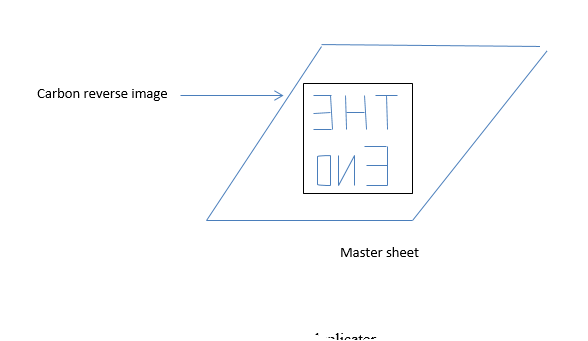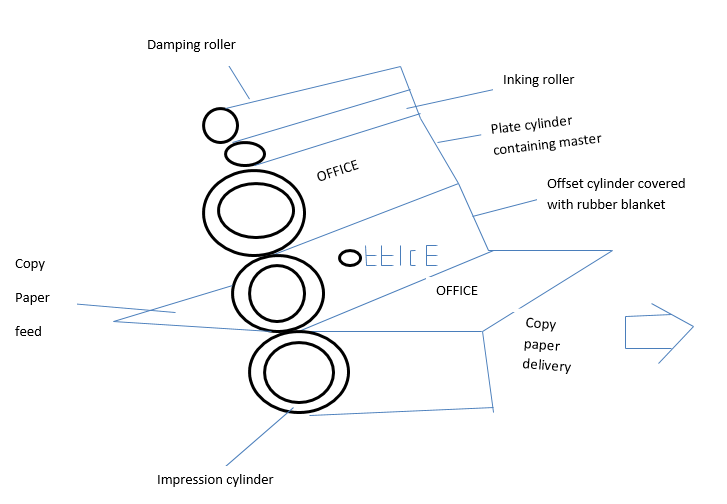Reprography refers to the variety of processes used to make a number of copies from a master.
A master is made from the original copy.
Copies are made from the master.
In duplication the master could either be a spirit master, a stencil or a plate.
Photocopying is a reprographic method. Its only deference with duplicating is that in photocopying copies are produced from the original document. You do not need to prepare a master
METHODS OF REPROGRAPHY
- Carbon copying – also called manifoldling
Carbon papers are used to produce either handwritten copies (e.g. in duplicate books) or typewritten copies.
A standard typewriter reproduces 2 – 10 copies for small numbers of copies while an electric typewriter reproduces 5 – 10 copies.
Advantages
- It is cheap method of obtaining copies for small numbers of copies
- Doesn’t require special skills
Disadvantages
- Not easy to correct
- Produces few copies
- Carbon copies tend to fade if stored for too long
- Spirit duplicating
The master copy is backed with a hectograph carbon sheet. Once you type, write or draw on the master, the reverse side of the master gets an impression but in carbon form.

The master sheet is fixed to the cylinder of the duplicator.
As the cylinder is rotated a blank copy paper is fed into the machine and is moistened with spirit from a reservoir in the machine.
When the dampened blank copy paper is pressed against the master copy, the carbon image is transferred in positive from on the blank copy paper.

Advantages
- Cheap and economical for producing small number of copies i.e. 10 – 300 copies
- Preparation of the master is simple. You can type or handwrite with a ball point pen or sharp pencil
- A spirit duplicator is easy to operate
- Several colors can be produced by using different colored carbons
- Errors can be corrected easily by scrapping the carbon impression with a knife specially made for this purpose
Disadvantages
- A limited number of copies obtained from one master
- Copies tend to fade if exposed to light
- Spirit used could present a fire hazard if not properly stored
- INK/STENCIL DUPLICATING
The master copy is a stencil.
Kinds of stencils and method to produce them
- Standard typewriting stencil – ordinary manual or electric typing
- Extra fine stencils – vari-type machine
- Thermal stencil – thermal heat copier
- Electronic stencils – using electronic stencil cutter
- Double-coated hand written stencil – for writing/drawing using a special pen called a stylus pen
- Tracing stencils – translucent
- Pre-cut stencils
Parts of a stencil
- Heading or head piece
- Stencil sheet
- Backing sheet
- Carbon sheet
The stencil master copy is fixed over the roller of the ink duplicator.
Copy paper is fed into the machine and once the handle is turned round in case of manual duplicator or power switched on in case of electric duplicator, ink is pressed through the cuts in the stencil printing the information on the stencil onto the copy paper.
This method reproduces 50 – 5000 copies
Advantages
- A relatively large number of copies can be obtained from each stencil
- A stencil can be stored and re-used several times
- An ink duplicator is relatively easy to operate
- Alterations to the stencil can be done easily
- Copies do not deteriorate over a period of time
- More than one color can be used
- The errors can be corrected easily be using the correcting fluid
- Stencils can be stored in a folder and the folder placed in a stencil box, cabinet drawer or a tray
- Grafting enables a large are e.g. a faulty paragraph to be corrected by cutting another stencil and fixing it on cut off section to be corrected
Disadvantages
- Costly for production of small number of copies
- Separate runs and separate stencils are required for producing copies in two or more colors
- Once used, master cannot be altered
- Absorbent copy paper is unsatisfactory for handwriting
- OFF-SET LITHOGRAPHY
The master copy is a plate made of either paper, plastic or metal.
Plates may be prepared by:
- Writing or drawing
- Typing on a typewriter fitted with a litho ribbon
- Electronic scanner
- The process relies on the fact that oil and water will not mix
- The master is fixed round a cylinder which is brought into contact with damping rollers, that is, rollers smeared with water and then ink rollers
- The unwritten parts of the master become wet and therefore cannot pick up printing ink while the written portions reject water and take in ink
- The inked portions come into contact to a second roller which is wrapped a soft rubber sheet known as a blanket
- The written portion or inked image is transferred (offset) on the blanket roller as a negative image
- When the blanket roller is brought in contact with the copy paper fed between it and an impression roller, the reversed/negative image on the blanket roller is transferred as a positive image on the copy paper
- The number of copies that can be produced with this method range from 500 – 50000 copies

Advantages
- High quality copies produced
- Larger quantities of copies can be reproduced
- The copy paper need not be of any special variety i.e. ordinary papers can be used
- The plates can be stored and used many times
- Suitable for production of office forms especially those with complicated rulings
- Different color printing and typefaces or sizes can be used
Disadvantages
- Expensive capital outlay for machinery
- It needs specialized and trained operators especially for more advanced applications
- Separate runs required for different colors
- Not economical for short run application
- Additional office space required for duplicating and stores for machinery
- NO CARBON REQUIRED (NCR)
This is a special kind of paper coated with a chemical substance on the reverse side which produced carbon copies when the top of the paper is written or typed on without using ordinary carbon paper
Advantage
- Cheap to use
- Saves time in form filling
- Neatness is maintained as opposed to carbon copy where handling of carbon papers causes fingers as well as forms to be dirty
- No skills is required – office staff can use them easily
- Simultaneous copies obtained
- Helps to achieve uniformity in the use of forms
Disadvantages
- More expensive than ordinary forms
- Mistakes cannot be easily corrected
- Bottom copies may appear faint
- Can be spoiled easily and wasted
- The papers must be handled very carefully because chemical coating is sensitive
- Accidental pressure is likely to make marks on the copies
- PHOTOCOPYING OR COPYING MACHINES
A copying machine produces an exact copy offer called a photocopy, from the original document
There is no need to prepare master
There are different types of copiers and several copying processes which include;
- Electronic
- Thermographic
- Dyeline
- Transfer diffusion
The common principle in the working of photocopying machines is that a document to be copied is fed into machine together with a blank sheet for every copy required. After processing the original emerges together with the required number of copies.
There is no limit as to the number of copies produced.
Advantages
- Convenience – copies can be obtained when they are required. No time is lost through preparation of master copy
- Speed – a copy is produced in a matter of seconds. The speed of making copies is the same whether the material is complicated or simple
- The possibility of a copying error (as might occur in the preparation of masters for duplicating) is eliminated. Every detail on an original is certain to be copied
- There is no limit to the number of copies which can be obtained
- Generally copying machines are easy to operate
- Colored copies can be obtained in some machines
- The quality of the original doesn’t deteriorate with many runnings
- Large sized documents can be reduced by some machines
Disadvantages
- The initial cost of some machines is relatively high
- Certain materials – special papers and chemicals must be used in their operation
- It is expensive where a number of copies are required
- Because of its conveniency it is liable to be used unnecessarily
- Some machines do not copy colors or ball-pen ink
FACTORS INFLUENCING THE CHOICE OF A REPROGRAPHIC METHOD
- The state of neatness required. Some reproduction methods produce very neat documents while others do not.
- The availability of the reproduction means. One can only choose a reproduction method that is available.
- The status of the user. If one is sending the documents to high-ranking officers, the method of reproduction chosen should be one that will produce highly presentable documents.
- The cost of production. The method chosen should be cost effective.
- The quality required. Some reproduction methods are suitable for the production of many documents while others are suitable for a few documents. For example, a duplicating machine is suitable for the reproduction of a few documents.
- The urgency of reproducing the documents. Some methods are slow while others are quite fast.
- Types of documents to be reproduced. Some methods of reproducing may not be able to reproduce some details in a document while others will produce a photographic copy of the original.
- Type of copy paper required.
- Number of colors required.
- Economy in operation.
- Durability of the copy and of the master copy.
Other machines used in the reprographic department to assist in completion of reprographic work
- Collating machine – assembles duplicated documents comprising a number of papers such as a report before being fastened together.
- Stapler machine – used for fixing papers together using staples
- Jogger – vibrate papers together into alignment before fastening i.e. stapling or binding
- Guillotine – trims papers into required size or to remove rough edges
REVISION QUESTIONS
- State the duplicating method you would use to reproduce the following:
- 5,000 copies of a circular to school parents
- Two copies of a single-spaced typewritten letter
- State three reasons why banks prefer to use No Carbon Required (NCR) on deposit slips
- State six factors that should be considered when choosing a method of reprography
- State three reasons why carbon copying may not be a popular method of reproducing documents in an office
- Outline the factors that should be considered when choosing a method of reproducing documents in an office
- Outline three disadvantages of using spirit duplicators to reproduce documents
- Outline four benefits that an organization may get from the use of ink duplication to reproduce documents or highlight the benefits that may accrue to an organization that uses a well maintained ink duplicator
- State three advantages of using the photocopier to make copies of a document or highlight five circumstances under which an organization may use a photocopier to reproduce documents or outline five merits of using tkhe photocopying method to reproduce documents or the Office Manager of Zilo Limited prefers to use the photocopying method to reproduce office documents. Explain five reasons that may account for this preference.
- State three limitations of using photocopying services to reproduce documents in an office
- Explain five ways in which photocopying may be misused by office staff
- Explain six factors that should be considered in determining the type of machine to be used for reproducing documents
